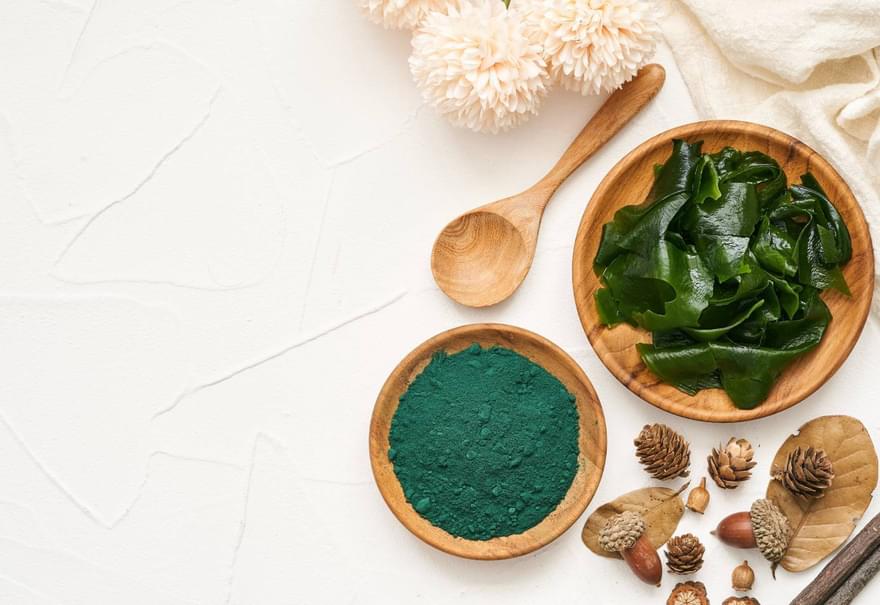
Sea Vegetables: A Garden Under the Sea for Your Dog?
Guest Blog: Anna Webb
Sea vegetables help sustain ecosystems, boost the planet’s oxygen supply, could these ‘veggies’ be good for dogs?
Guest Blog: Dr. Conor Brady
Many raw feeders are borderline obsessed with their dogs' stool and for good reason. You're most likely to come to fresh feeding for one of two reasons – either someone you know and trust recommended you look into it, or you have a dog with a recurring skin or gut condition. If you're in the gut-sick group a solid stool can bring a tear of joy to the hardiest of folk. These people have been through it.

Many raw feeders are borderline obsessed with their dogs' stool and for good reason. You're most likely to come to fresh feeding for one of two reasons – either someone you know and trust recommended you look into it, or you have a dog with a recurring skin or gut condition. If you're in the gut-sick group a solid stool can bring a tear of joy to the hardiest of folk. These people have been through it. Conventional vets struggle to fix gut issues as they believe ultra-processed dry food is the only thing dogs can eat. With no fix in site, owners are in and out of the vets on a near weekly basis for repeat prescriptions of powerful meds, all an effort to quieten the symptoms of an unhappy gut. It's so stressful but worse, clearly, for the dog. So, I rejoice with them when they send a picture of their dogs' doings, usually with the title “check this out!”. These emails always come in around breakfast. My wife thinks I'm a freak that I can happily read such messages over a bowl of porridge, but the reason is simple - that's another dog on the mend.
You can tell a lot
from a poop. It's the window to the digestive system. For those that haven't
thought about it as much as me (I studied poop as part of my doctorate, so few
have, in fairness), poo is simply the undigested matter you ate in the first
place. No better or worse than that. It smells because bacteria have been
fermenting it and their farts tend to stink. At least, the farts of the wrong
bacteria stink. A good diet generally doesn't produce an offensive odour.
When I see horse poo on the ground I just undigested grass. When I see an owl pellet, I see digested mice. When I see a big, stinking, joke-shop-esque, non-anal-gland-expressing pile of dry-fed dog poo on the path, I see a heap of undigested matter and genuinely feel sorry for the dog that passed it.
There are lots of things we can use to measure a good poop – size, shape, texture, colour, smell and frequency. To get us started, let's look at the Bristol Stool Chart, what we use to measure stool quality in humans:
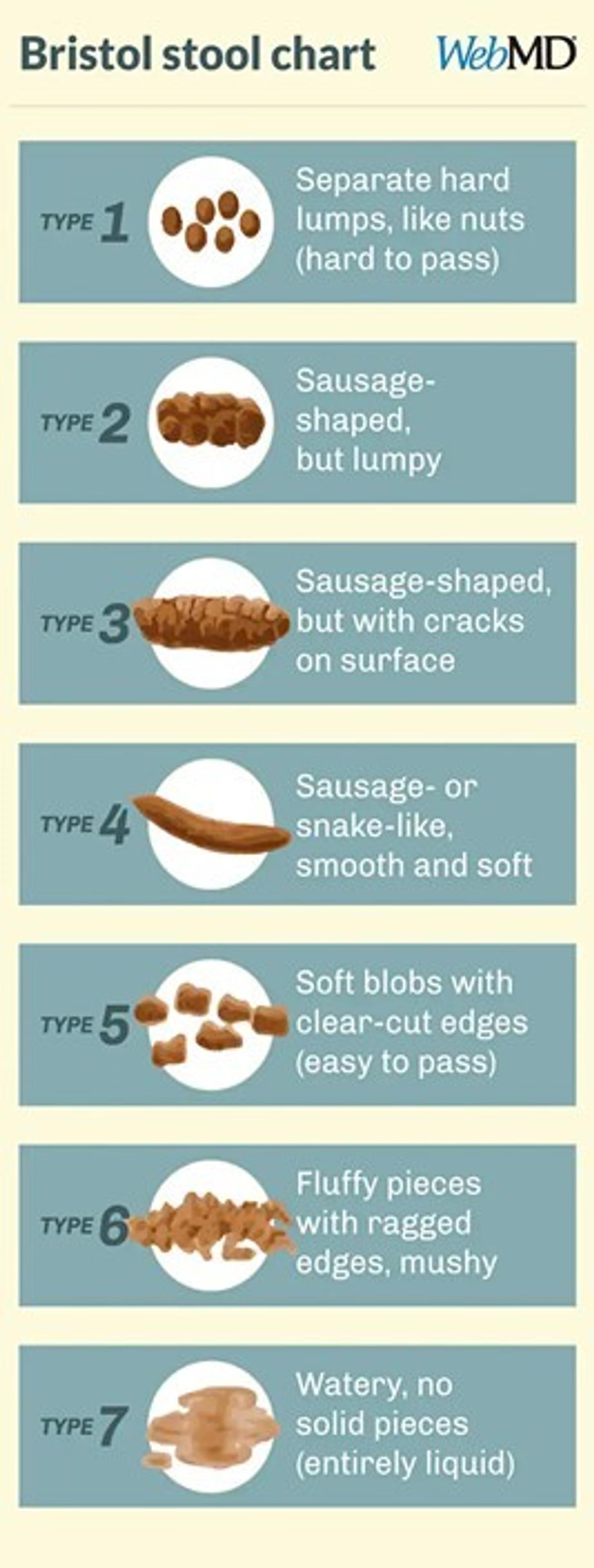
In omnivorous, plant-eating humans, the ideal stool is generally type 3 or 4 – easy to pass logs without being too watery. We eat a lot of plant matter, so any undigested fibre hits the colon where it sucks in water. That bulks the poo, giving it the shape, you're looking at (the shape of our intestines). Obviously, you don't want too much water (types 5, 6, and 7, moving towards diarrhea) as that suggests something's wrong. Nor do you want your stools too firm either (type 1 or 2). Hard little pellets suggest you're either dehydrated or more likely constipated and require more fibre in your diet. You should never have to struggle to go to the toilet.
Roughly the same principles apply in raw-fed dogs with a few tweaks along the way. Dr Nick Thompson uses a scale of 1-10 to score stools in his canine patients, where 1 is brown soup and 9-10 is the perfect log. You should be picking up these logs with two fingers, if so desired. It's a surprisingly effective way to get new clients to score their dogs average stool quality. Both Nick and I accept nothing less than 9's or 10's from a dog, anything less needs attention.
But before we get into the shitty nitty gritty, a differentiation is needed:
Dry-fed dogs
The above chart will do the job for dry-fed dogs as they are consuming, very sadly, a mostly vegetarian diet. Dry food, with its' 50-60% grain or sweet potato coupled with lots of cheap, indigestible, plant-based filler ingredients such as beet pulp, corn gluten and soy bean hull etc, is notoriously high in indigestible plant fibre, which has the same effect in dogs as it does in humans, only more so. In keeping with their evolutionary diets, dogs, like all carnivores, have smooth, short and fast digestive systems. They process meals quickly. If you add too much plant fibre in there, the dogs' rapid, acidic system is too poorly equipped to digest it. In the colon and via osmosis, the undigested matter draws water into the digesta resulting in get big, wet stools passing through the colon like a hot snot down a chrome nostril. If this occurs repeatedly, he can develop issues with his anal glands, the two little secretory organs at 4 and 8 o'clock around his anus that secrete a pheromone onto the stool. Too many soft stools, coupled with the systemic inflammation we discuss below, results in these little organs inflaming and impacting, often requiring manual expression by your vet and potentially setting your dog up for a lifetime of trouble in this area.
Inside, the problems continue. Dogs are carnivores. They do not, cannot, house the bacteria necessary to fully digest all that plant matter. This means more undigested matter passes through the system, favouring the growth of other, wrong bacteria down the line. Now, instead of all the good stuff they get from their normal, friendly (commensal) gut biota, you get the build-up of toxins from pathogenic bacteria (the ones with the smelly farts). Added to this, dry food is chock full of chemical preservatives to preserve it during long storage times, chemicals that also napalm your dog’s gut flora. The inevitable disruption of flora on this junk food results in a shifting of the resident gut species (dysbiosis), poor nutrient absorption and intestinal inflammation. Allowed to persist and you're heading towards an IBS-type diagnosis from the conventional vet who believes, absolutely incorrectly, that dry food plays some role in the solution. Antibiotics are prescribed, which work temporarily to clear the infection but ultimately leave a barren space to be populated by the resident bacteria...who are the bad guys. And on to the hamster wheel of ill health the dog goes.
Raw-fed dogs
So dry-fed dog stools will resemble that of a human - big, long, soft, smooth logs - but this is not what the average, appropriately-fed dog poo should look like. Most on here realise the importance of fresh, biologically appropriate food for dogs. To get an idea of what a meat-fed dogs' poo might look like when fed this diet, let's take a look at this wolf stool.
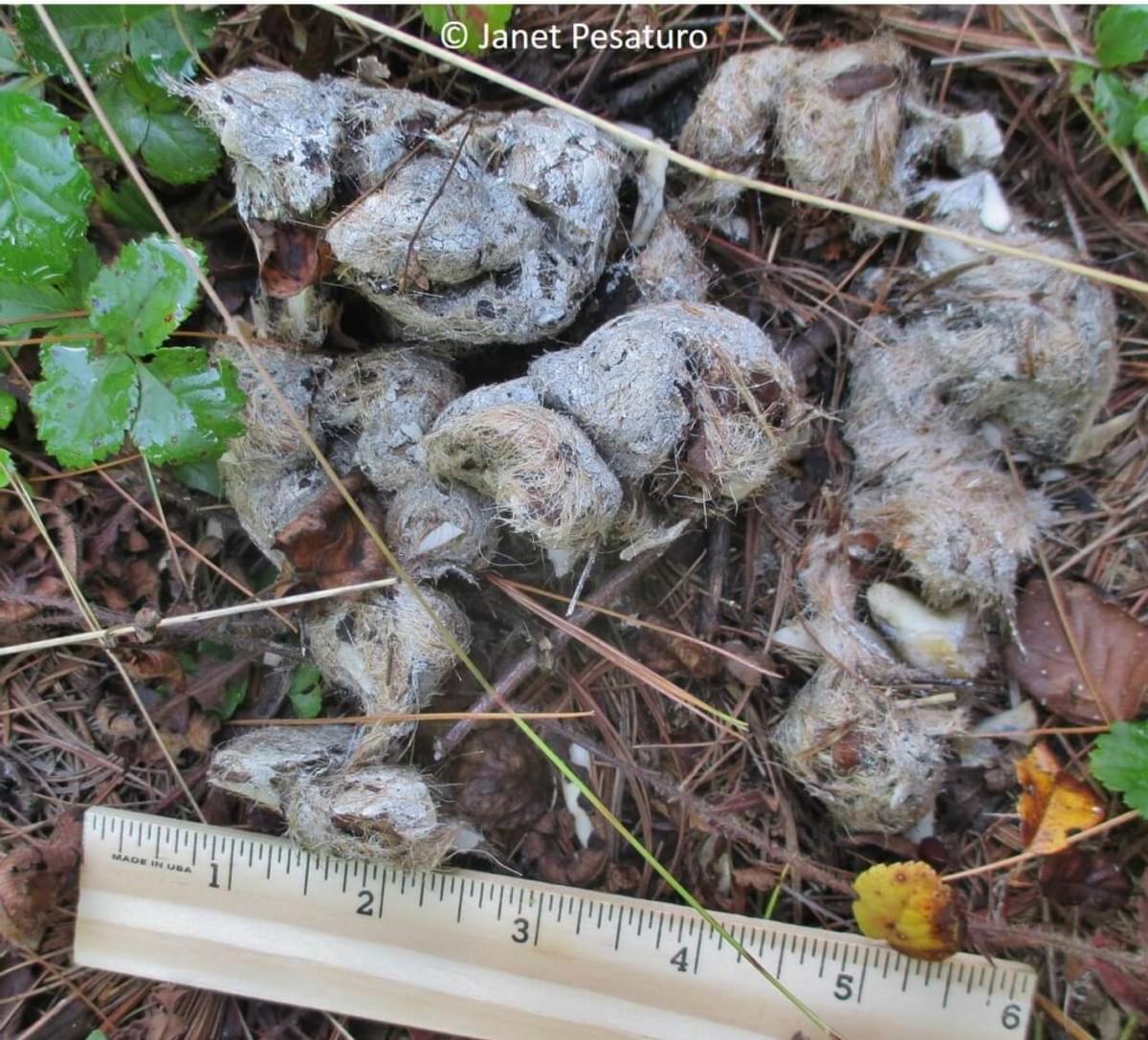
No brown logs here. Carnivore stools contain all the undigested matter of an animal meal – brown/black (high blood meal) with lots of hair, fur, feather and hide mixed in. Most look like this. With wolves, all their undigested matter moves to the butt end, resulting in their poo starting off very firm and gets softer as they keep going.
But Conor, dogs are not wolves. Correct. They are 30-40,000 years away from being a wolf. So distant they don't even interbreed much. So, let's stop talking about them. Let's talk about Dingoes, so close to dogs (they diverged around 4,000 years ago) that they are freely interbreeding, today endangering the species as a whole. Dingoes have a diet of 97% animal matter. It won't surprise you that their stool is virtually identical to that of every other carnivore out there.
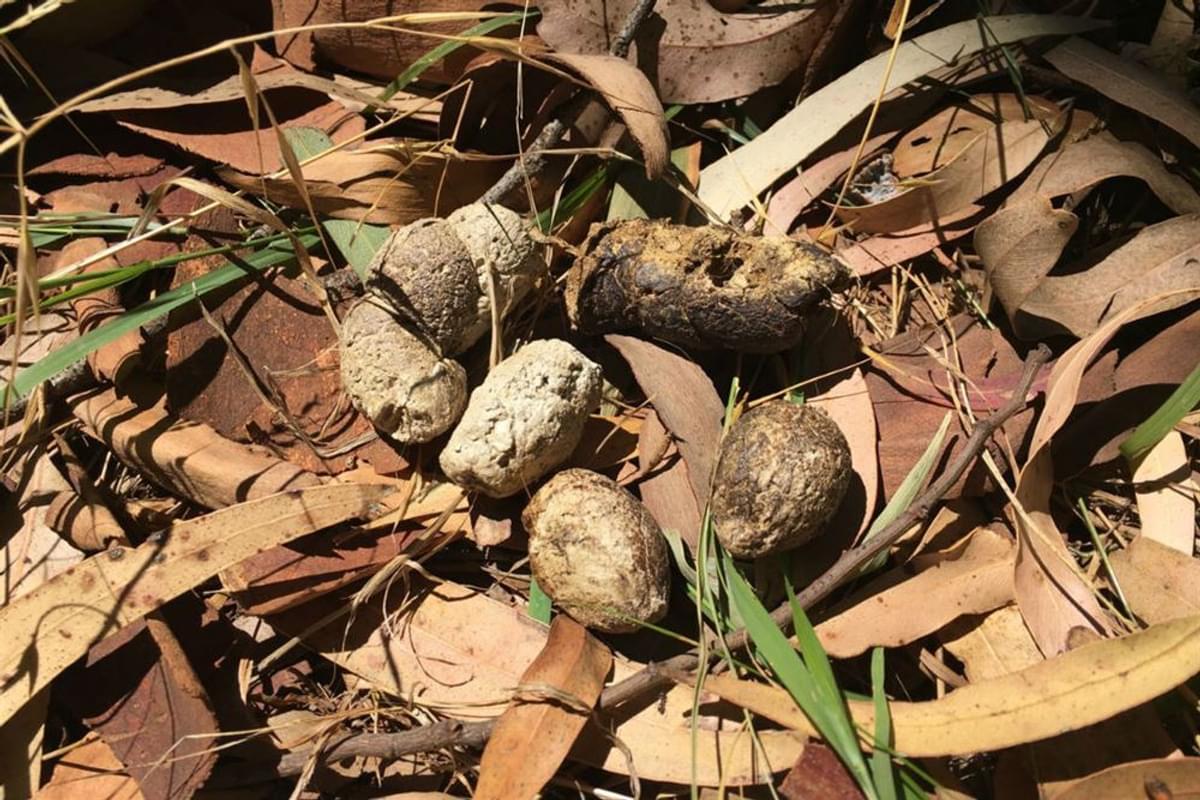
With raw-fed dogs, we see the same rules apply. If you feed a dog a whole-prey diet, including the outer hairy bits, feet, beaks etc, you will get a stool that looks like the carnivores above, of course.
And we know this is the case with truly feral dogs (dogs that never associate with humans) – their stools are do identical to wolf stool that geneticists get very confused with the two when conducting wolf scat analysis (REF).
However, most of us do not feed dogs’ entire prey. The majority of raw feeders are using pre-made raw dog food. Manufacturers of these rarely include the indigestible bits, out of ignorance of their importance to the dog (vital to their digestive tract health) or, more likely, because if you saw some feathers and a mouse tail sticking of out your food, quicker than you could say “carnivore fibre” most would be on Facebook complaining about the horrible, cheap filler being used by your insidious supplier. An education campaign is badly needed here.
Without these additions, anyone feeding carnivore fibre-less pre-made with no added plant matter can expect dogs have to have firmer poops. As we want them to have firmer poops (compared to the usual dry-fed slop), as long as they're not straining this is not such a bad thing. Meat contains its share of fibre, dogs can only digest 70-90% of a meat meal, depending on which animal you use (red meat one end, white fish the other).
Interestingly, without a lot of indigestible fibre (be it hair or plant) sucking water into the colon, helping everything to move along, it's not unusual for such dogs to be pretty sensitive to the amount of bone in their mixes, readily putting out hard little white nuggets that characterises such a meal. It makes them great sentinels for poorer quality raw dog foods made largely on bony necks and carcass. This is why manufacturers of such products often use plant material such as root veg in their mixes (high in fibre) masking the constipating effect of their high bone and relatively meat-less mixes.
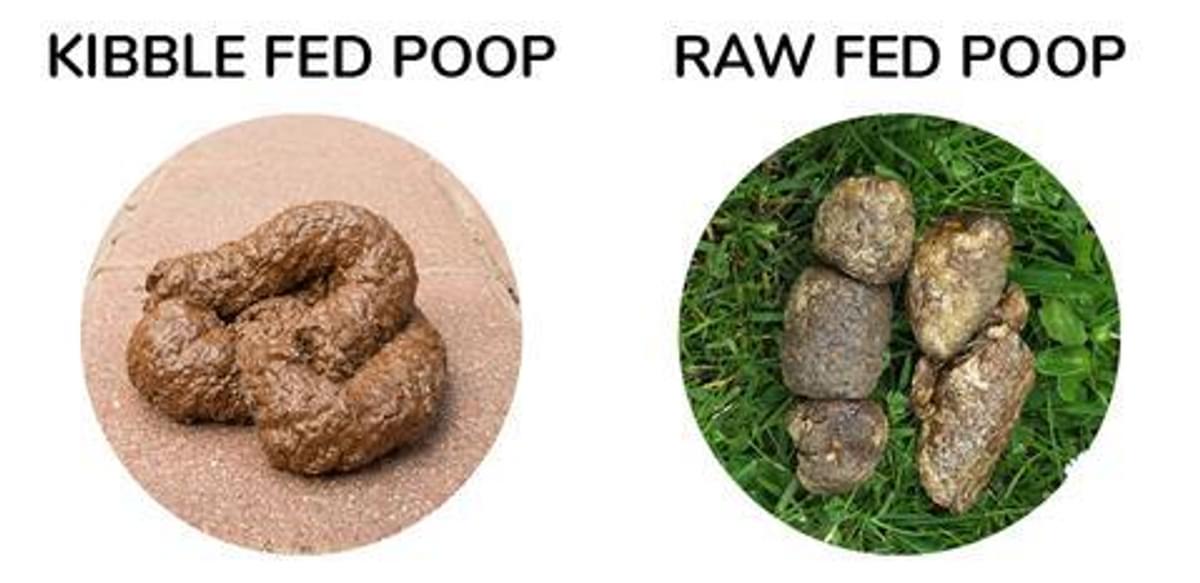
The majority of raw feeders, in my opinion, use a little plant matter (often cooked, breaking down the plant fibre, meaning less hits the colon, making for better digestion and ultimately stools), largely veg, maybe a bit of fruit. The very clear benefits of all those phytonutrients aside, I believe that bit of plant fibre, in the absence of a variety of real carnivore fibre, is not a bad thing in raw-fed dogs.
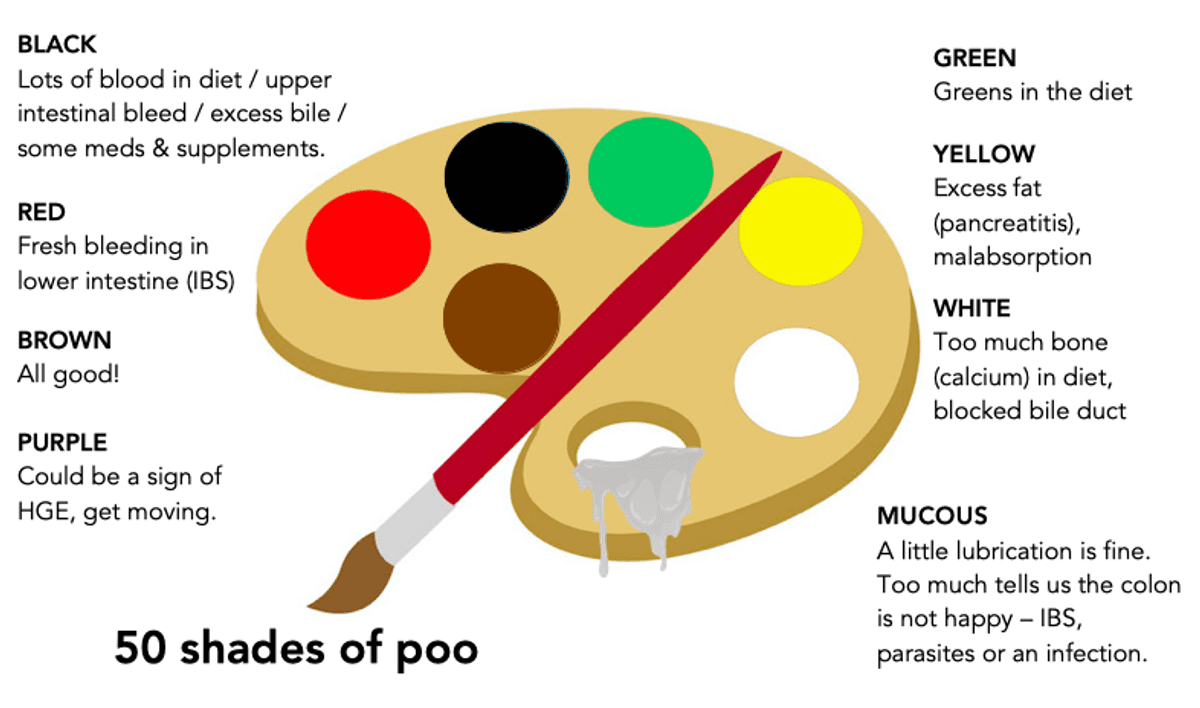
You can tell a lot from the colour of your dog’s poo. Here are some of the crucial ones:
Brown. Your poop is brown because of bilirubin which is a metabolite of iron-rich heme (the precursor to haemoglobin which bind oxygens in the bloodstream). This compound is naturally dark brown in colour. The more red blood cells you break down, the darker brown your poo is. Hence, raw-fed dog poo (and most carnivore poo) is often black while dry-fed dogs are always light brown, a colour that is more likely to be the result of the colourants used in the product (as kibble is grey without such additions).
Orange. Food is passing through too quick and isn't getting digested properly. Not a happy gut. Likely some malabsorption Less bilirubin results in a more orangey colour to the stool. going on. Make some tweaks.
Black. Too much blood (as above) and your poo can go black. But if your dog isn't getting more blood in his diet, it can be a sign of darker happenings such as a bleeding ulcer in the stomach or upper intestines. You would think this would make it redder however the blood is digested before it reaches the stool. They could also have eaten some aspirins or even rat poison. Iron supplements will do it to them too, as will bismuth (Pepto-Bismol).
Red. Unsurprisingly, red poop could mean bleeding in the lower intestinal tract, particularly splotches of very fresh red, such as dogs with IBS. In these patients, they poo so much and so often, that the delicate mucosal lining is worn away (that's the mucous sleeve on the stools of such dogs), exposing the fragile capillaries underneath. Easily torn, these add blood to the stool which doesn't have time to be digested. There are other maladies that can cause fresh blood – an injust in your dog’s rectum, an infection in your dog’s anus or anal glands or even a tumour in the hind gut area. While foods like beets or tomato juice can turn poop red as well (who is feeding lots of that?!), don't ignore sudden fresh blood (unless IBS dog where a little is nearly expected).
Pink or purple. If their stool looks like raspberry jam, it could be a symptom of haemorrhagic gastroenteritis. This requires immediate veterinary attention. HGE can be caused by disease, parasites or eating something toxic.
White-ish. If their poop is drier and is a whiter shade it probably means they've just eaten a lot of bone. The body only needs so much calcium, the rest it expels. However, it could also be a symptom of a lack of bile from their liver and gallbladder, indicating the duct may be blocked. Medications like anti-diarrhoea medicine can make their poo pale too.
White specs in a brown poop is different. That could be worm eggs...suggest sending a poo sample off to wormcount.co.uk in the UK or IrishEquineResearch in Ireland for them to check. Cheap and definitive.
Many observe that you don't see so many white poos on the pavement anymore. I'm confident that this is down to the fact most dogs are now sadly dry fed. These products use a terrible amount of chemical preservative to keep them from going off in their paper bags. Mould won't even grow on the stuff two years later. This chemical anti-life washes over your own dog’s gut flora, napalming the delicate life there but it all comes out in their stool too. It makes sense to me that nothing wants to eat it.
Yellow. Greasy, stinky, grey-ish yellow stool in big, soft mounds may be a sign of too much fat. As dogs are so good with fat, it's more commonly a sign that the fat wasn't digested in the first place, indicating an enzyme / pancreatic issue.
Green. Green really only comes from the food they eat. If you feed too much spinach you might see a good deal in the poo. Simply feeding too much indigestible plant material can cause a green-ish hue too. In this case, their stools are passing through too fast, nothing is getting absorbed or digested so there's less brown-tinting bilirubin present and more bile salts which are a green-colour. Or maybe your dog is eating waaay too much grass which suggests something is not right internally.
Of all bad stools you're going to experience from your dog, the most common by a long way is diarrhoea. Clearly something is not agreeing with him. In this case, you can stop feeding them for a bit, at least 24hrs. Give the tum some time off. During their little fast I would leave out filtered or boiled-then-cooled (i.e. dechlorinated) water and a second bowl of the same water but with two little additions that I first dissolve in a little hot water in a mug. The first is a healthy pinch of good quality salt (anything with a name – Himalayan Rock Salt, Pink Salt, Oriel Sea Salt etc). This contains their electrolytes which take a battering with diarrhoea as they manage the whole water process in your back end. The second addition is a nice tablespoon of local, raw honey. It's antibacterial and a nice source of energy. His next few meals should be something very simple – like tinned salmon and quinoa, or scrambled egg and porridge. Give his gut time to reset. If particularly bad, a little organic, German Chamomile is great. If looking for a supplement to use in this situation, our product BF8 is becoming a veterinary favourite. Containing German chamomile and a few other key additions, it's highly effective.

Guest Blog: Anna Webb
Sea vegetables help sustain ecosystems, boost the planet’s oxygen supply, could these ‘veggies’ be good for dogs?
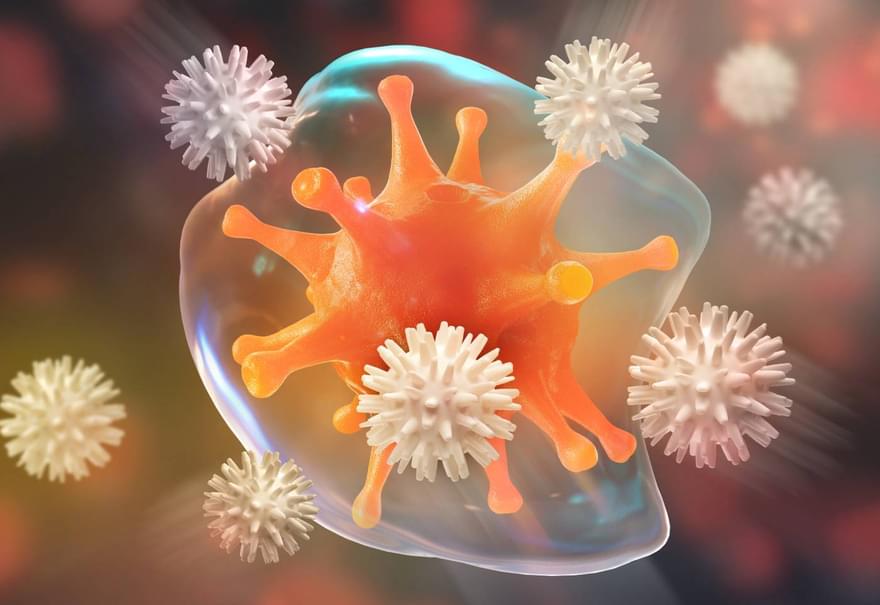
Your dog's body is a sophisticated arrangement of organs, cells and proteins all tasked with safeguarding the body from infections. So what is the best way to support this unique system?

The rebrand comes with a captivating new packaging design that perfectly reflects ‘optimum raw nutrition for dogs’.